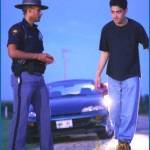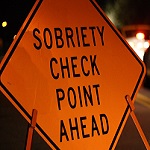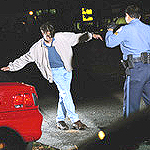Standardized DUI Field Sobriety Tests
 If a motorist is stopped by the police for a traffic violation and the police officer suspects that the motorist may be intoxicated, then the police officer will transition the traffic stop into a DUI investigation. The police officer will ask the motorist to perform a battery of field sobriety tests or exercises; however, these field sobriety exercises are voluntary. A motorist is never required to perform any field exercises. However, if a driver agrees to perform field tests and does not successfully perform to the police officer’s subjective satisfaction along with an odor of an alcoholic beverage and an admission to recent consumption of alcohol, then the police officer now has likely gathered evidence of probable cause to make an arrest for suspicion of driving under the influence of alcohol or drugs. ***** NOTE: There is almost no scenario where a motorist should perform these voluntary exercises. *****
If a motorist is stopped by the police for a traffic violation and the police officer suspects that the motorist may be intoxicated, then the police officer will transition the traffic stop into a DUI investigation. The police officer will ask the motorist to perform a battery of field sobriety tests or exercises; however, these field sobriety exercises are voluntary. A motorist is never required to perform any field exercises. However, if a driver agrees to perform field tests and does not successfully perform to the police officer’s subjective satisfaction along with an odor of an alcoholic beverage and an admission to recent consumption of alcohol, then the police officer now has likely gathered evidence of probable cause to make an arrest for suspicion of driving under the influence of alcohol or drugs. ***** NOTE: There is almost no scenario where a motorist should perform these voluntary exercises. *****
Field Sobriety Tests are ALWAYS Voluntary
 In 1982, the National Highway Traffic and Safety Administration (NHTSA) established three official tests for police officers to use when investigating a DUI suspect and to determine if a particular driver is intoxicated. These field sobriety tests examine a driver’s coordination, balance, and dexterity, all of which are affected when a person’s blood alcohol content (“BAC”) increases. Many of the tests also help the police officer determine if the driver is able to perform simple tasks simultaneously since alcohol impairment diminishes the ability to divide attention among multiple tasks. There are many different types of field tests such as reciting the alphabet, counting, finger dexterity, finger to nose – among other exercises – that a police officer may request a person to take; however, there are only three standard tests established by NHTSA that are administered under conditions with adequate lighting and on level, dry ground. NOTE: There are also countless other ailments or other conditions such as having a medical condition or being obese or elderly that can cause one to perform poorly on these exercises that have nothing to do with alcohol consumption.
In 1982, the National Highway Traffic and Safety Administration (NHTSA) established three official tests for police officers to use when investigating a DUI suspect and to determine if a particular driver is intoxicated. These field sobriety tests examine a driver’s coordination, balance, and dexterity, all of which are affected when a person’s blood alcohol content (“BAC”) increases. Many of the tests also help the police officer determine if the driver is able to perform simple tasks simultaneously since alcohol impairment diminishes the ability to divide attention among multiple tasks. There are many different types of field tests such as reciting the alphabet, counting, finger dexterity, finger to nose – among other exercises – that a police officer may request a person to take; however, there are only three standard tests established by NHTSA that are administered under conditions with adequate lighting and on level, dry ground. NOTE: There are also countless other ailments or other conditions such as having a medical condition or being obese or elderly that can cause one to perform poorly on these exercises that have nothing to do with alcohol consumption.
Horizontal Gaze Nystagmus (HGN)
 The Horizontal Gaze Nystagmus test is a field sobriety test that is NHTSA approved. When a police officer asks the motorist to perform this field sobriety test, the police officer will be looking for any involuntary jerking of the eyes, which is often caused by alcohol consumption. However, nystagmus can occur naturally, due to other reasons and/or without the presence of alcohol consumption. The police officer will instruct the motorist to follow a stimulus such as a pen or flashlight with the eyes.
The Horizontal Gaze Nystagmus test is a field sobriety test that is NHTSA approved. When a police officer asks the motorist to perform this field sobriety test, the police officer will be looking for any involuntary jerking of the eyes, which is often caused by alcohol consumption. However, nystagmus can occur naturally, due to other reasons and/or without the presence of alcohol consumption. The police officer will instruct the motorist to follow a stimulus such as a pen or flashlight with the eyes.
In each eye, the police officer is looking for three clues: 1) a lack of smooth pursuant when following the stimulus; 2) any jerking occurring when the eye is looking at the stimulus at maximum deviation; and, 3) any jerking that starts before 45 degrees. According to the NHTSA study, if the police officer properly conducts the test and four factors occurring between the two eyes are present, then it is possible that the BAC of the motorist is at least .10% and is over Virginia’s legal limit of .08%.
Failing the HGN field sobriety test does not automatically result in proof beyond a reasonable doubt that the motorist is driving under the influence of alcohol. In fact, many people suffer from a natural nystagmus in their eyes. There are other factors that may trigger nystagmus, such as: the police officer moving the stimulus too quickly, making the stimulus come to close to the motorist’s eyes or by not allowing the motorist enough time to follow it during the test. Furthermore, despite its approval by NHTSA, many courts have ruled that the test is not scientifically reliable.
One Leg Stand
 Alcohol is a depressant that slows down the body’s central nervous system. This can cause an inability to maintain balance. If a motorist is suspected of DUI in Virginia, then the police officer may have the motorist perform a field sobriety test known as the One Leg Stand. This field sobriety test is approved by NHTSA. According to the NHTSA study, this test should not be offered by the investigating police officer if the motorist is over 65 years old or more than 50 pounds overweight or suffers from a physical disability.
Alcohol is a depressant that slows down the body’s central nervous system. This can cause an inability to maintain balance. If a motorist is suspected of DUI in Virginia, then the police officer may have the motorist perform a field sobriety test known as the One Leg Stand. This field sobriety test is approved by NHTSA. According to the NHTSA study, this test should not be offered by the investigating police officer if the motorist is over 65 years old or more than 50 pounds overweight or suffers from a physical disability.
The One Leg Stand is a divided attention test designed to see if the motorist can follow instructions as well as perform the tasks required. The police officer will instruct the motorist to raise one leg, with the foot approximately six inches off the ground, keeping arms to the side at all times, watch the raised foot, and count to 30. The police officer will score you on 1) swaying while balancing, 2) using your arms for balance, 3) hopping, 4) putting your foot down and 5) inability to complete the test by putting your foot down more than two times. If two of any of these clues occur, then it is said that the motorist failed the One Leg Stand according to NHTSA.
The test conditions are imperative. The test must be administered on a hard, dry, level surface. The police officer also needs to make sure the testing spot is in a safe place so that if the motorist should fall, then the motorist will not be in danger. The police officer should also provide lighting if the traffic stop occurs during the night. The police officer’s flashlight can be used to illuminate the ground. A good rule to go by is if you and the police officer can see each other well. Finally, if the motorist is wearing shoes with heels more than two inches high, then the police officer should instruct the motorist to remove the heels if necessary.
Nine Step Walk And Turn
 The police officer may also have the motorist perform a field sobriety test known as the 9 Step Walk and Turn. This field sobriety test is also approved by NHTSA. Prior to administering the test, the police officer must first demonstrate what the motorist is required to do. According to the NHTSA study, this test should not be offered by the investigating police officer if the motorist is over 65 years old or more than 50 pounds overweight or suffers from some other physical disability.
The police officer may also have the motorist perform a field sobriety test known as the 9 Step Walk and Turn. This field sobriety test is also approved by NHTSA. Prior to administering the test, the police officer must first demonstrate what the motorist is required to do. According to the NHTSA study, this test should not be offered by the investigating police officer if the motorist is over 65 years old or more than 50 pounds overweight or suffers from some other physical disability.
The 9 Step Walk and Turn test is a divided attention test designed to see if the motorist can follow instructions as well as perform the tasks required. The police officer will instruct nine steps to be walked, heel to toe, on either a line or an imaginary line, turn on a pivot, then walk back nine steps heel to toe on the same line. This test must be performed while keeping arms by one’s side at all times and while counting each step out loud.
The police officer will be looking to see 1) if the motorist can keep balance while listening to the instructions, 2) if the motorist starts the test when told to do so, 3) if the motorist has to stop walking to maintain balance, 4) that each step is heel to toe, 5) if the motorist steps off the line, 6) if the motorist uses arms for balance, 7) if the motorist took the wrong number of steps, 8) if the motorist lost balance during the pivot, 9) or if the motorist cannot complete the test. If two of these clues are present, then you have failed this field sobriety test according to the NHTSA study.
Let us review YOUR case today. We can help!
11/10/2015 | Updated 4/29/2018
